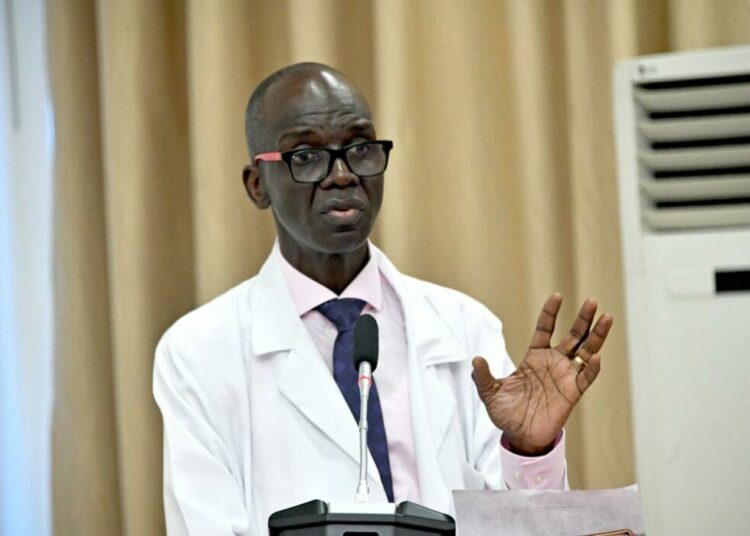Future of Fat Loss: Neurosurgeon Reveals Groundbreaking Nerve Zapper Therapy

The story of Kelly Owens, a 29-year-old who sent a heartfelt 'Thank you' to neurosurgeon Dr. Kevin Tracey for saving her life, embodies a groundbreaking medical revolution centered on the vagus nerve. From the age of 13, Kelly endured the debilitating symptoms of Crohn’s disease and inflammatory arthritis, two incurable autoimmune conditions that caused severe inflammation, pain, fatigue, and diarrhea. After years on potent steroids, she developed osteoporosis, a common side-effect of prednisone, leaving her doctors without further solutions. Her worsening condition forced her to abandon her teaching career, with her legs often too swollen to walk, requiring her husband to carry her.
Dr. Kevin Tracey, a world expert in the vagus nerve, became the recipient of Kelly's gratitude in 2017. The vagus nerve, the body's longest nerve, extends from the brain's base to the lower torso, carrying vital signals between the brain and major organs like the heart, lungs, and digestive system. It regulates crucial bodily processes, including heart and breathing rates. Often referred to as the 'super highway' of the nervous system due to its extensive reach, Dr. Tracey likens its intricate workings to an orchestra, where its approximately 200,000 nerve fibers 'vibrate in tune with health'.
Dr. Tracey made a landmark discovery in the early 1990s, demonstrating a crucial link between the immune system and the brain through the vagus nerve. His research showed that stimulating this nerve could effectively treat inflammation. In his lab at the Feinstein Institutes in New York, while studying an artificial anti-inflammatory molecule called CNI-1493, Dr. Tracey and his team unexpectedly found that administering CNI-1493 into the brain of rodents reduced inflammatory cytokines throughout the body. This effect occurred despite the low dose, which was insufficient to enter the bloodstream. Further experimentation, where the vagus nerve of the mice was severed, revealed that the anti-inflammatory effect ceased. This radical conclusion established that the vagus nerve regulates the immune system through an 'anti-inflammatory healing reflex', as detailed in his book, The Great Nerve: The New Science Of The Vagus Nerve. This insight suggested the possibility of regulating inflammation using devices that stimulate the vagus nerve, a groundbreaking concept at a time when nerve stimulation was primarily used for epilepsy to prevent seizures.
Following this discovery, Dr. Tracey founded Setpoint Medical to develop a device that uses electrical impulses to stimulate the vagus nerve for treating inflammation. Kelly Owens, living in New Jersey, learned about Dr. Tracey's work online after a severe Crohn's flare-up in 2015 led to her hospitalization. Inspired by his research on treating autoimmune conditions, she joined a clinical trial in 2017. A small, muffin-sized device was implanted beneath her collarbone, with a lead connected to her vagus nerve, programmed to activate two or three times daily for several minutes to reduce inflammation by inhibiting it in the spleen, with systemic effects. Within weeks, Kelly was able to walk without a cane for the first time since her teenage years. Eight weeks later, her gastrointestinal symptoms disappeared, and within months, she was steroid-free. Dr. Tracey confirms Kelly remains well, personally and professionally, even pursuing a hobby of building custom guitars, an astonishing feat given her previous crippling pain in her hands and joints. Her remarkable improvement, he emphasizes, underscores the promise of vagus nerve stimulation (VNS) and bioelectronic medicine, a promise recently acknowledged by the US medical regulator, the FDA, which approved the Setpoint implant for patients with rheumatoid arthritis whose condition is not adequately controlled by medication.
The vagus nerve is currently experiencing a significant moment, with millions of social media hashtags touting its importance and techniques like meditation, Wim Hof-style ice baths, and deep breathing gaining popularity for their VNS benefits. Beyond these, Dr. Tracey's research extends to the potential of VNS in easing digestive conditions such as Crohn's and IBS, and more controversially, its future role in weight loss. Dr. Tracey believes VNS could ultimately replace GLP-1 injectable drugs like Mounjaro and Ozempic, arguing that their underlying mechanism already relies on neural signaling through the vagus nerve. Each vagus nerve fiber contributes to coordinating bodily processes, including digestion, nutrient absorption, liver regulation of blood sugar, and pancreatic insulin release – all vital for maintaining a healthy weight. Dr. Tracey explains that GLP-1 injections curb appetite and decrease blood glucose by activating vagus nerve circuits that signal the brain and liver to regulate metabolism. He cites a key trial where GLP-1s had no effect on food intake or stomach emptying in patients whose vagus nerve had been severed during ulcer surgery, unlike control groups.
A significant advantage of VNS devices over GLP-1 injections, according to Dr. Tracey, is their near absence of side-effects. While drugs spread throughout the body, causing issues like constipation, nausea, diarrhea, and in extreme cases, pancreatitis and muscle loss, nerve fibers are specific, targeting particular functions in precise locations. This specificity suggests the potential for future selective stimulation of vagus nerve fibers to achieve benefits without adverse effects. Dr. Tracey envisions vagus nerve activating devices for obesity and weight management becoming widely available within the next five to ten years. Moreover, non-invasive VNS methods are being explored; a 2021 study published in Scientific Reports showed that focused ultrasound directed at the vagus nerve near the liver in mice not only caused significant weight loss and reduced inflammatory cytokines but also targeted belly fat. This method appears to activate vagus nerve fibers in the liver that convey satiety signals to the brain, enhancing feelings of fullness more quickly.
Dr. Ahmed Albusoda, a consultant gastroenterologist at Royal London and Whipps Cross Hospital, shares optimism for VNS in treating gut conditions, citing a 2020 review in the Journal of Anatomy that found VNS can reduce pain, including gut pain. He views VNS as a form of 'physiotherapy for the nervous system' but expresses caution regarding its current efficacy for weight loss, noting it is not yet as powerful or predictable as GLP-1s, and research into stimulating the bowel to trigger GLP-1 release remains experimental. Despite the powerful potential of VNS, its widespread adoption faces challenges, including ongoing research, the need for further regulatory approval (like from the FDA), and a perceived lack of profit motive for drug companies. Technical hurdles such as determining the optimal 'dose' – pulse strength, duration, and exact application location – also exist, as does the imperative to map vagus nerve fibers to understand their specific bodily effects.
Nevertheless, Dr. Albusoda affirms that 'the evidence is building that the vagus nerve influences pain, inflammation and digestion.' He advocates for clinicians to consider vagal function when treating conditions like IBS, anxiety-related gut symptoms, and chronic pain, moving beyond purely 'in the head' or 'in the gut' perspectives. With the aid of artificial intelligence to fine-tune stimulation patterns, he anticipates the next decade will bring 'personalised electroceuticals' – gentle, data-guided electrical therapies that could complement existing medicines. Ultimately, the future of medicine may increasingly focus on tackling underlying causes, potentially rooted in the vagus nerve, rather than merely treating symptoms with drugs.
For those interested in 'DIY vagus nerve stimulation,' Dr. Tracey suggests monitoring vagal tone. A key indicator is a healthy heart rate (60-100 beats per minute) and high heart rate variability (HRV), measurable with an ECG or even a smartwatch. Low vagal tone can manifest as stress, anxiety, digestive issues like acid reflux, raised blood pressure, fatigue, and brain fog. Dr. Tracey strongly advocates for exercise, cold-water exposure, meditation, and deep breathing as methods to enhance vagal tone, possibly by increasing vagus nerve signals that activate brain regions associated with positive emotions and suppressing inflammation, or by impacting the diaphragm, which affects the nerve.
You may also like...
Super Eagles vs Gabon: Osimhen Arrives, Underdog Claims Fuel Pre-Match Fire
)
Super Eagles star Victor Osimhen has joined the Nigeria squad in Morocco, completing the team's camp amidst pre-match te...
Ariana Grande's Wild Lie Detector Confession: Moon Landing Doubts & Earthly Woes

Ariana Grande returned to the press tour for "Wicked: For Good" where she humorously but emphatically addressed the moon...
Michael Jackson Biopic Trailer Shatters Viewership Records with 116 Million Views

The upcoming Michael Jackson biopic, "Michael," has already shattered records, with its teaser trailer becoming the most...
UK Fights Digital Piracy: Amazon Fire TV Stick Crackdown Intensifies

A major crackdown has begun on Amazon Fire TV Stick users accessing illegal streams, with industry experts calling it a ...
Controversial Take: Celebrity Gehgeh Claims Men Do Women a Favor by Marrying Them

Social media personality Gehgeh has sparked a heated debate with his controversial comments on marriage traditions durin...
Nigeria Unveils 'Detty December' Task Force, Establishes Tourism Economic Zones

Nigeria's Federal Executive Council has approved three key initiatives to boost the nation's art, culture, and tourism s...
A Nation's Shame: Nigerian Children Suffer Malnutrition Due to Neglect

Nigeria's northwest faces a severe malnutrition crisis, impacting children and costing the nation billions annually. Fed...
WHO Sounds Alarm: Africa Faces Diabetes Crisis as Insulin Access Dwindles

The World Health Organisation (WHO) is urging Africa to strengthen primary healthcare and boost investment to tackle a r...


:max_bytes(150000):strip_icc()/CottageCheese-99217feea01d4cd3b886474147f153a8.jpg)
